Critical Evaluation of Systems Thinking in Contemporary Organizations
VerifiedAdded on 2022/11/16
|6
|1690
|223
Essay
AI Summary
This essay critically evaluates the relevance of systems thinking and systems management within contemporary organizations, particularly in the context of a global business environment. It defines systems thinking as a holistic approach that examines the interrelationships of different parts within an organizational structure, emphasizing its importance in decision-making, especially in complex and rapidly changing environments. The essay highlights the multidimensional nature of organizational systems and the significance of systems thinking in addressing challenges posed by globalization and technological advancements. It explores the advantages of systems thinking, such as enhanced decision-making and adaptability, while also acknowledging its limitations, including the difficulty of practical implementation and the broad scope of the field. The essay concludes by emphasizing the importance of understanding both the strengths and weaknesses of systems thinking for effective organizational management. It also includes references to academic sources that support the analysis.

Running head: CONTEMPORARY ORGANIZATIONS
CONTEMPORARY ORGANIZATIONS
Name of the student
Name of the university
Author Note
CONTEMPORARY ORGANIZATIONS
Name of the student
Name of the university
Author Note
Paraphrase This Document
Need a fresh take? Get an instant paraphrase of this document with our AI Paraphraser
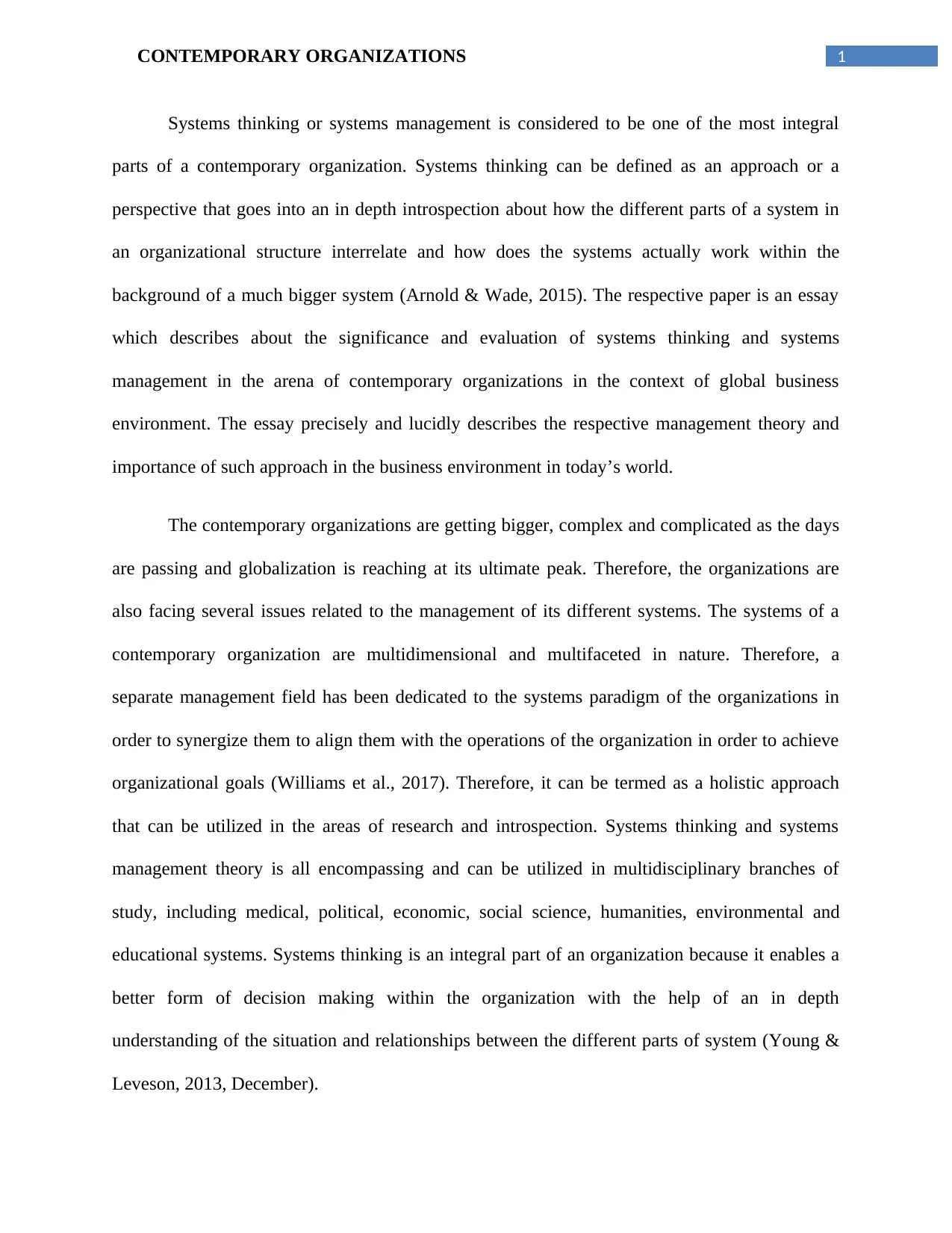
1CONTEMPORARY ORGANIZATIONS
Systems thinking or systems management is considered to be one of the most integral
parts of a contemporary organization. Systems thinking can be defined as an approach or a
perspective that goes into an in depth introspection about how the different parts of a system in
an organizational structure interrelate and how does the systems actually work within the
background of a much bigger system (Arnold & Wade, 2015). The respective paper is an essay
which describes about the significance and evaluation of systems thinking and systems
management in the arena of contemporary organizations in the context of global business
environment. The essay precisely and lucidly describes the respective management theory and
importance of such approach in the business environment in today’s world.
The contemporary organizations are getting bigger, complex and complicated as the days
are passing and globalization is reaching at its ultimate peak. Therefore, the organizations are
also facing several issues related to the management of its different systems. The systems of a
contemporary organization are multidimensional and multifaceted in nature. Therefore, a
separate management field has been dedicated to the systems paradigm of the organizations in
order to synergize them to align them with the operations of the organization in order to achieve
organizational goals (Williams et al., 2017). Therefore, it can be termed as a holistic approach
that can be utilized in the areas of research and introspection. Systems thinking and systems
management theory is all encompassing and can be utilized in multidisciplinary branches of
study, including medical, political, economic, social science, humanities, environmental and
educational systems. Systems thinking is an integral part of an organization because it enables a
better form of decision making within the organization with the help of an in depth
understanding of the situation and relationships between the different parts of system (Young &
Leveson, 2013, December).
Systems thinking or systems management is considered to be one of the most integral
parts of a contemporary organization. Systems thinking can be defined as an approach or a
perspective that goes into an in depth introspection about how the different parts of a system in
an organizational structure interrelate and how does the systems actually work within the
background of a much bigger system (Arnold & Wade, 2015). The respective paper is an essay
which describes about the significance and evaluation of systems thinking and systems
management in the arena of contemporary organizations in the context of global business
environment. The essay precisely and lucidly describes the respective management theory and
importance of such approach in the business environment in today’s world.
The contemporary organizations are getting bigger, complex and complicated as the days
are passing and globalization is reaching at its ultimate peak. Therefore, the organizations are
also facing several issues related to the management of its different systems. The systems of a
contemporary organization are multidimensional and multifaceted in nature. Therefore, a
separate management field has been dedicated to the systems paradigm of the organizations in
order to synergize them to align them with the operations of the organization in order to achieve
organizational goals (Williams et al., 2017). Therefore, it can be termed as a holistic approach
that can be utilized in the areas of research and introspection. Systems thinking and systems
management theory is all encompassing and can be utilized in multidisciplinary branches of
study, including medical, political, economic, social science, humanities, environmental and
educational systems. Systems thinking is an integral part of an organization because it enables a
better form of decision making within the organization with the help of an in depth
understanding of the situation and relationships between the different parts of system (Young &
Leveson, 2013, December).
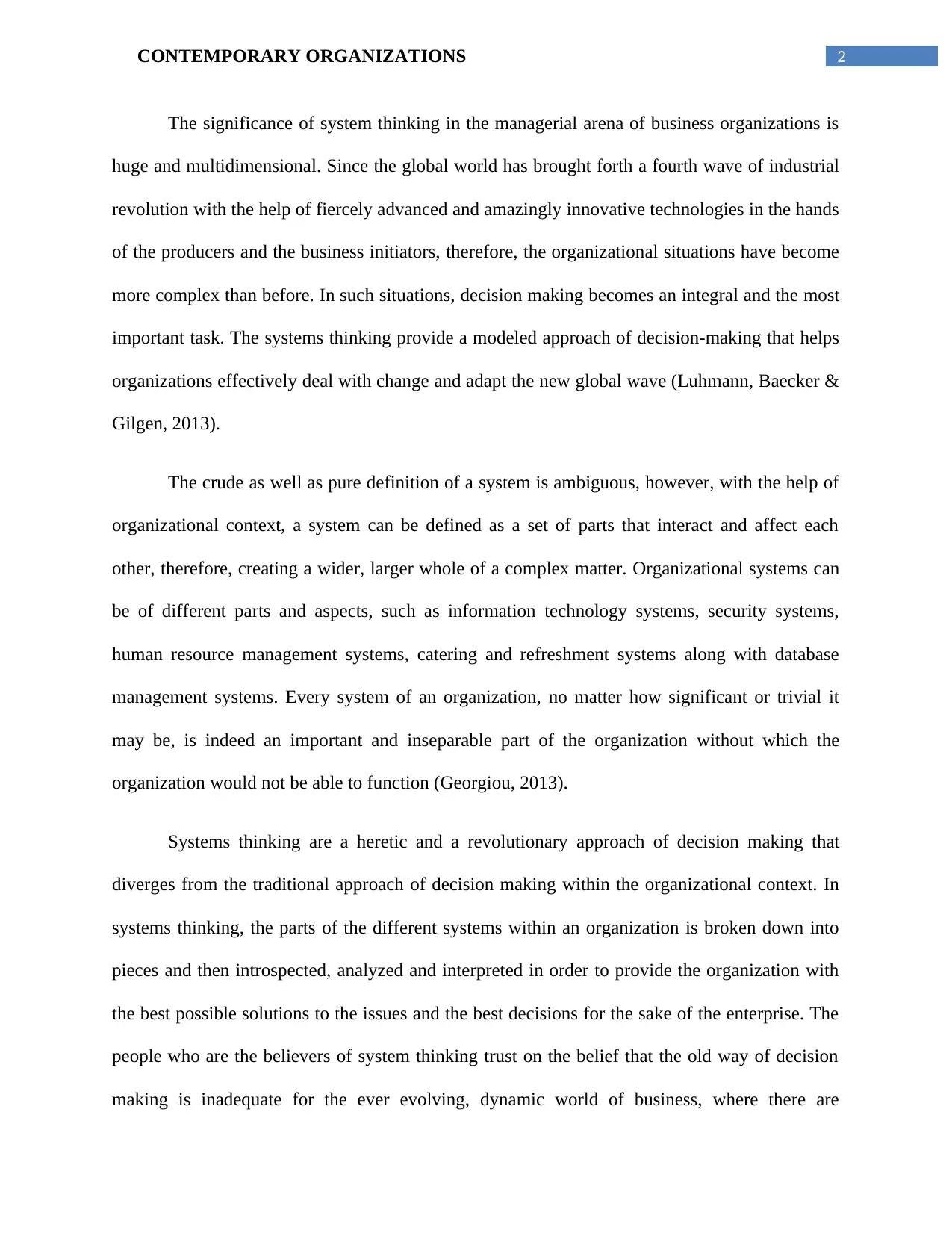
2CONTEMPORARY ORGANIZATIONS
The significance of system thinking in the managerial arena of business organizations is
huge and multidimensional. Since the global world has brought forth a fourth wave of industrial
revolution with the help of fiercely advanced and amazingly innovative technologies in the hands
of the producers and the business initiators, therefore, the organizational situations have become
more complex than before. In such situations, decision making becomes an integral and the most
important task. The systems thinking provide a modeled approach of decision-making that helps
organizations effectively deal with change and adapt the new global wave (Luhmann, Baecker &
Gilgen, 2013).
The crude as well as pure definition of a system is ambiguous, however, with the help of
organizational context, a system can be defined as a set of parts that interact and affect each
other, therefore, creating a wider, larger whole of a complex matter. Organizational systems can
be of different parts and aspects, such as information technology systems, security systems,
human resource management systems, catering and refreshment systems along with database
management systems. Every system of an organization, no matter how significant or trivial it
may be, is indeed an important and inseparable part of the organization without which the
organization would not be able to function (Georgiou, 2013).
Systems thinking are a heretic and a revolutionary approach of decision making that
diverges from the traditional approach of decision making within the organizational context. In
systems thinking, the parts of the different systems within an organization is broken down into
pieces and then introspected, analyzed and interpreted in order to provide the organization with
the best possible solutions to the issues and the best decisions for the sake of the enterprise. The
people who are the believers of system thinking trust on the belief that the old way of decision
making is inadequate for the ever evolving, dynamic world of business, where there are
The significance of system thinking in the managerial arena of business organizations is
huge and multidimensional. Since the global world has brought forth a fourth wave of industrial
revolution with the help of fiercely advanced and amazingly innovative technologies in the hands
of the producers and the business initiators, therefore, the organizational situations have become
more complex than before. In such situations, decision making becomes an integral and the most
important task. The systems thinking provide a modeled approach of decision-making that helps
organizations effectively deal with change and adapt the new global wave (Luhmann, Baecker &
Gilgen, 2013).
The crude as well as pure definition of a system is ambiguous, however, with the help of
organizational context, a system can be defined as a set of parts that interact and affect each
other, therefore, creating a wider, larger whole of a complex matter. Organizational systems can
be of different parts and aspects, such as information technology systems, security systems,
human resource management systems, catering and refreshment systems along with database
management systems. Every system of an organization, no matter how significant or trivial it
may be, is indeed an important and inseparable part of the organization without which the
organization would not be able to function (Georgiou, 2013).
Systems thinking are a heretic and a revolutionary approach of decision making that
diverges from the traditional approach of decision making within the organizational context. In
systems thinking, the parts of the different systems within an organization is broken down into
pieces and then introspected, analyzed and interpreted in order to provide the organization with
the best possible solutions to the issues and the best decisions for the sake of the enterprise. The
people who are the believers of system thinking trust on the belief that the old way of decision
making is inadequate for the ever evolving, dynamic world of business, where there are
⊘ This is a preview!⊘
Do you want full access?
Subscribe today to unlock all pages.

Trusted by 1+ million students worldwide
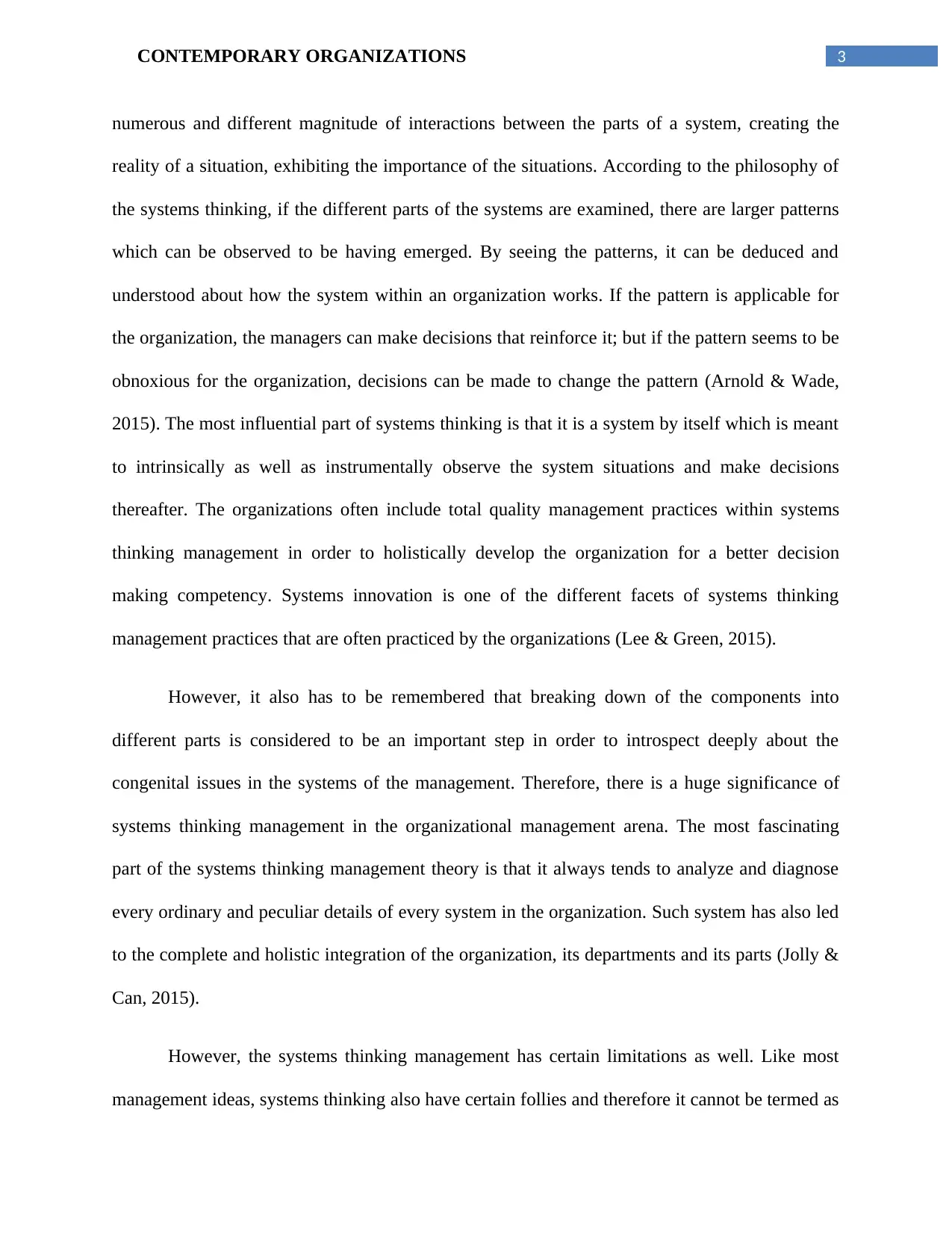
3CONTEMPORARY ORGANIZATIONS
numerous and different magnitude of interactions between the parts of a system, creating the
reality of a situation, exhibiting the importance of the situations. According to the philosophy of
the systems thinking, if the different parts of the systems are examined, there are larger patterns
which can be observed to be having emerged. By seeing the patterns, it can be deduced and
understood about how the system within an organization works. If the pattern is applicable for
the organization, the managers can make decisions that reinforce it; but if the pattern seems to be
obnoxious for the organization, decisions can be made to change the pattern (Arnold & Wade,
2015). The most influential part of systems thinking is that it is a system by itself which is meant
to intrinsically as well as instrumentally observe the system situations and make decisions
thereafter. The organizations often include total quality management practices within systems
thinking management in order to holistically develop the organization for a better decision
making competency. Systems innovation is one of the different facets of systems thinking
management practices that are often practiced by the organizations (Lee & Green, 2015).
However, it also has to be remembered that breaking down of the components into
different parts is considered to be an important step in order to introspect deeply about the
congenital issues in the systems of the management. Therefore, there is a huge significance of
systems thinking management in the organizational management arena. The most fascinating
part of the systems thinking management theory is that it always tends to analyze and diagnose
every ordinary and peculiar details of every system in the organization. Such system has also led
to the complete and holistic integration of the organization, its departments and its parts (Jolly &
Can, 2015).
However, the systems thinking management has certain limitations as well. Like most
management ideas, systems thinking also have certain follies and therefore it cannot be termed as
numerous and different magnitude of interactions between the parts of a system, creating the
reality of a situation, exhibiting the importance of the situations. According to the philosophy of
the systems thinking, if the different parts of the systems are examined, there are larger patterns
which can be observed to be having emerged. By seeing the patterns, it can be deduced and
understood about how the system within an organization works. If the pattern is applicable for
the organization, the managers can make decisions that reinforce it; but if the pattern seems to be
obnoxious for the organization, decisions can be made to change the pattern (Arnold & Wade,
2015). The most influential part of systems thinking is that it is a system by itself which is meant
to intrinsically as well as instrumentally observe the system situations and make decisions
thereafter. The organizations often include total quality management practices within systems
thinking management in order to holistically develop the organization for a better decision
making competency. Systems innovation is one of the different facets of systems thinking
management practices that are often practiced by the organizations (Lee & Green, 2015).
However, it also has to be remembered that breaking down of the components into
different parts is considered to be an important step in order to introspect deeply about the
congenital issues in the systems of the management. Therefore, there is a huge significance of
systems thinking management in the organizational management arena. The most fascinating
part of the systems thinking management theory is that it always tends to analyze and diagnose
every ordinary and peculiar details of every system in the organization. Such system has also led
to the complete and holistic integration of the organization, its departments and its parts (Jolly &
Can, 2015).
However, the systems thinking management has certain limitations as well. Like most
management ideas, systems thinking also have certain follies and therefore it cannot be termed as
Paraphrase This Document
Need a fresh take? Get an instant paraphrase of this document with our AI Paraphraser
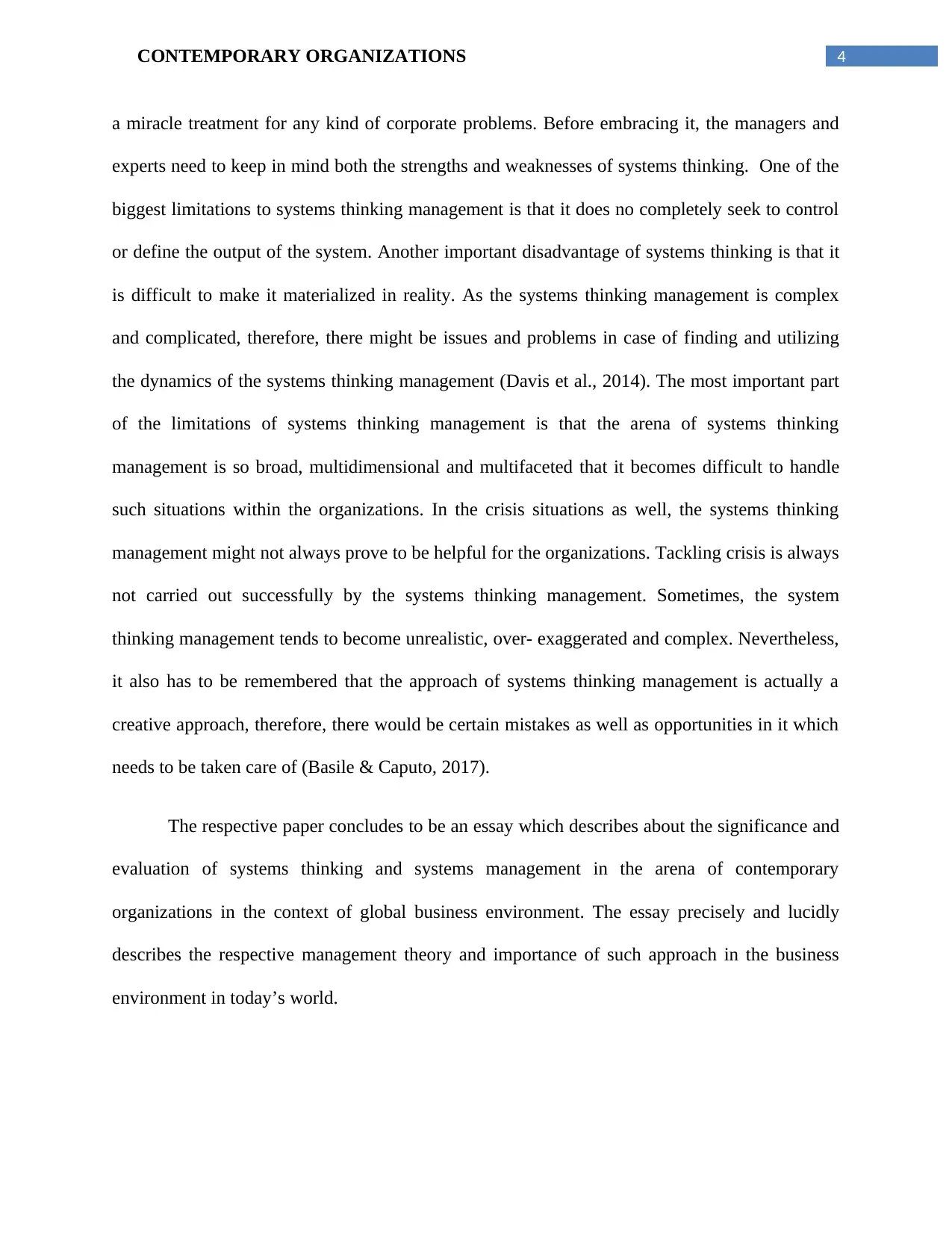
4CONTEMPORARY ORGANIZATIONS
a miracle treatment for any kind of corporate problems. Before embracing it, the managers and
experts need to keep in mind both the strengths and weaknesses of systems thinking. One of the
biggest limitations to systems thinking management is that it does no completely seek to control
or define the output of the system. Another important disadvantage of systems thinking is that it
is difficult to make it materialized in reality. As the systems thinking management is complex
and complicated, therefore, there might be issues and problems in case of finding and utilizing
the dynamics of the systems thinking management (Davis et al., 2014). The most important part
of the limitations of systems thinking management is that the arena of systems thinking
management is so broad, multidimensional and multifaceted that it becomes difficult to handle
such situations within the organizations. In the crisis situations as well, the systems thinking
management might not always prove to be helpful for the organizations. Tackling crisis is always
not carried out successfully by the systems thinking management. Sometimes, the system
thinking management tends to become unrealistic, over- exaggerated and complex. Nevertheless,
it also has to be remembered that the approach of systems thinking management is actually a
creative approach, therefore, there would be certain mistakes as well as opportunities in it which
needs to be taken care of (Basile & Caputo, 2017).
The respective paper concludes to be an essay which describes about the significance and
evaluation of systems thinking and systems management in the arena of contemporary
organizations in the context of global business environment. The essay precisely and lucidly
describes the respective management theory and importance of such approach in the business
environment in today’s world.
a miracle treatment for any kind of corporate problems. Before embracing it, the managers and
experts need to keep in mind both the strengths and weaknesses of systems thinking. One of the
biggest limitations to systems thinking management is that it does no completely seek to control
or define the output of the system. Another important disadvantage of systems thinking is that it
is difficult to make it materialized in reality. As the systems thinking management is complex
and complicated, therefore, there might be issues and problems in case of finding and utilizing
the dynamics of the systems thinking management (Davis et al., 2014). The most important part
of the limitations of systems thinking management is that the arena of systems thinking
management is so broad, multidimensional and multifaceted that it becomes difficult to handle
such situations within the organizations. In the crisis situations as well, the systems thinking
management might not always prove to be helpful for the organizations. Tackling crisis is always
not carried out successfully by the systems thinking management. Sometimes, the system
thinking management tends to become unrealistic, over- exaggerated and complex. Nevertheless,
it also has to be remembered that the approach of systems thinking management is actually a
creative approach, therefore, there would be certain mistakes as well as opportunities in it which
needs to be taken care of (Basile & Caputo, 2017).
The respective paper concludes to be an essay which describes about the significance and
evaluation of systems thinking and systems management in the arena of contemporary
organizations in the context of global business environment. The essay precisely and lucidly
describes the respective management theory and importance of such approach in the business
environment in today’s world.
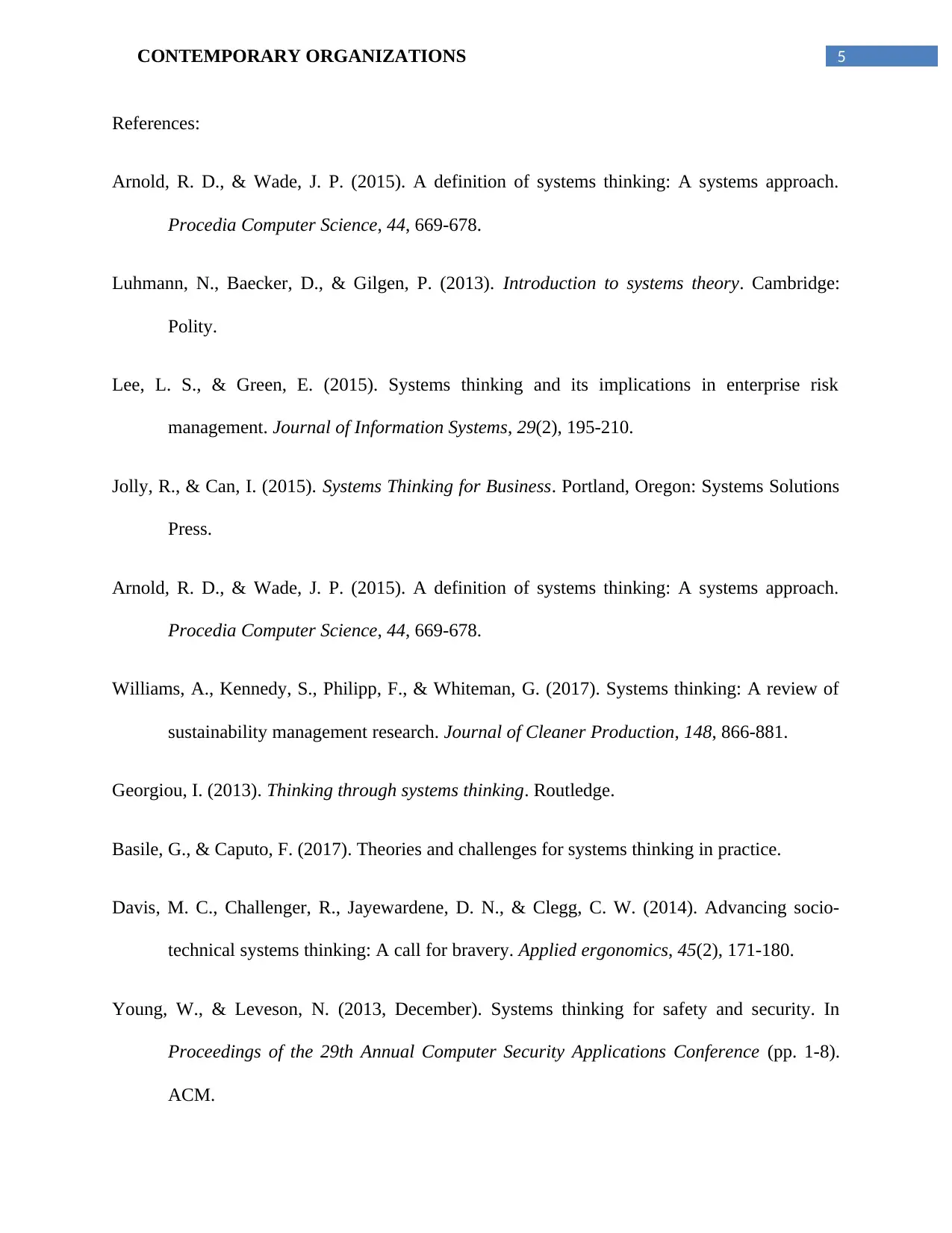
5CONTEMPORARY ORGANIZATIONS
References:
Arnold, R. D., & Wade, J. P. (2015). A definition of systems thinking: A systems approach.
Procedia Computer Science, 44, 669-678.
Luhmann, N., Baecker, D., & Gilgen, P. (2013). Introduction to systems theory. Cambridge:
Polity.
Lee, L. S., & Green, E. (2015). Systems thinking and its implications in enterprise risk
management. Journal of Information Systems, 29(2), 195-210.
Jolly, R., & Can, I. (2015). Systems Thinking for Business. Portland, Oregon: Systems Solutions
Press.
Arnold, R. D., & Wade, J. P. (2015). A definition of systems thinking: A systems approach.
Procedia Computer Science, 44, 669-678.
Williams, A., Kennedy, S., Philipp, F., & Whiteman, G. (2017). Systems thinking: A review of
sustainability management research. Journal of Cleaner Production, 148, 866-881.
Georgiou, I. (2013). Thinking through systems thinking. Routledge.
Basile, G., & Caputo, F. (2017). Theories and challenges for systems thinking in practice.
Davis, M. C., Challenger, R., Jayewardene, D. N., & Clegg, C. W. (2014). Advancing socio-
technical systems thinking: A call for bravery. Applied ergonomics, 45(2), 171-180.
Young, W., & Leveson, N. (2013, December). Systems thinking for safety and security. In
Proceedings of the 29th Annual Computer Security Applications Conference (pp. 1-8).
ACM.
References:
Arnold, R. D., & Wade, J. P. (2015). A definition of systems thinking: A systems approach.
Procedia Computer Science, 44, 669-678.
Luhmann, N., Baecker, D., & Gilgen, P. (2013). Introduction to systems theory. Cambridge:
Polity.
Lee, L. S., & Green, E. (2015). Systems thinking and its implications in enterprise risk
management. Journal of Information Systems, 29(2), 195-210.
Jolly, R., & Can, I. (2015). Systems Thinking for Business. Portland, Oregon: Systems Solutions
Press.
Arnold, R. D., & Wade, J. P. (2015). A definition of systems thinking: A systems approach.
Procedia Computer Science, 44, 669-678.
Williams, A., Kennedy, S., Philipp, F., & Whiteman, G. (2017). Systems thinking: A review of
sustainability management research. Journal of Cleaner Production, 148, 866-881.
Georgiou, I. (2013). Thinking through systems thinking. Routledge.
Basile, G., & Caputo, F. (2017). Theories and challenges for systems thinking in practice.
Davis, M. C., Challenger, R., Jayewardene, D. N., & Clegg, C. W. (2014). Advancing socio-
technical systems thinking: A call for bravery. Applied ergonomics, 45(2), 171-180.
Young, W., & Leveson, N. (2013, December). Systems thinking for safety and security. In
Proceedings of the 29th Annual Computer Security Applications Conference (pp. 1-8).
ACM.
⊘ This is a preview!⊘
Do you want full access?
Subscribe today to unlock all pages.

Trusted by 1+ million students worldwide
1 out of 6
Related Documents
Your All-in-One AI-Powered Toolkit for Academic Success.
+13062052269
info@desklib.com
Available 24*7 on WhatsApp / Email
![[object Object]](/_next/static/media/star-bottom.7253800d.svg)
Unlock your academic potential
Copyright © 2020–2025 A2Z Services. All Rights Reserved. Developed and managed by ZUCOL.





